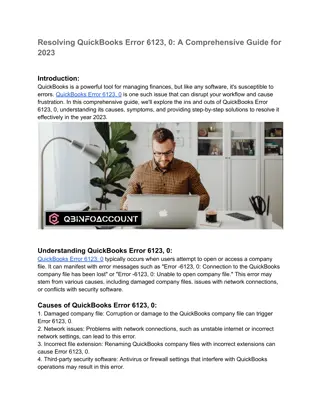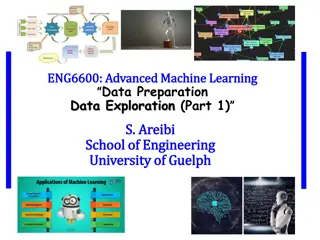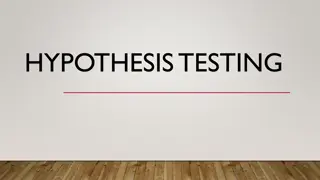Understanding Sources of Error in Machine Learning
This comprehensive overview covers key concepts in machine learning, such as sources of error, cross-validation, hyperparameter selection, generalization, bias-variance trade-off, and error components. By delving into the intricacies of bias, variance, underfitting, and overfitting, the material helps grasp the nuances of machine learning models' performance and accuracy.
Download Presentation

Please find below an Image/Link to download the presentation.
The content on the website is provided AS IS for your information and personal use only. It may not be sold, licensed, or shared on other websites without obtaining consent from the author. Download presentation by click this link. If you encounter any issues during the download, it is possible that the publisher has removed the file from their server.
E N D
Presentation Transcript
Sources of error CS771: Introduction to Machine Learning Nisheeth
2 Plan for today Understanding error in machine learning Cross-validation Learning with Decision Trees CS771: Intro to ML
3 Hyperparameter Selection Every ML model has some hyperparameters that need to be tuned, e.g., K in KNN or ? in ?-NN Choice of distance to use in LwP or nearest neighbors Would like to choose h.p. values that would give best performance on test data CS771: Intro to ML
Generalization Training set (labels known) Test set (labels unknown) How well does a learned model generalize from the data it was trained on to a new test set? Slide credit: L. Lazebnik CS771: Intro to ML
Generalization Components of generalization error Bias: how much the average model over all training sets differ from the true model? Error due to inaccurate assumptions/simplifications made by the model Variance: how much models estimated from different training sets differ from each other Underfitting:model is too simple to represent all the relevant class characteristics High bias and low variance High training error and high test error Overfitting:model is too complex and fits irrelevant characteristics (noise) in the data Low bias and high variance Low training error and high test error Slide credit: L. Lazebnik CS771: Intro to ML
Bias-Variance Trade-off Models with too few parameters are inaccurate because of a large bias (not enough flexibility). Models with too many parameters are inaccurate because of a large variance (too much sensitivity to the sample). Slide credit: D. Hoiem CS771: Intro to ML
Bias-Variance Trade-off E(MSE) = noise2 + bias2 + variance Error due to variance of training samples Error due to incorrect assumptions Unavoidable error See the following for explanations of bias-variance (also Bishop s Neural Networks book): http://www.inf.ed.ac.uk/teaching/courses/mlsc/Notes/Lecture4/BiasVariance.pdf Image credit: geeksforgeeks.com Slide credit: D. Hoiem CS771: Intro to ML
Bias-variance tradeoff Underfitting Overfitting Error Test error Training error High Bias Low Variance Low Bias High Variance Complexity Slide credit: D. Hoiem CS771: Intro to ML
Bias-variance tradeoff Few training examples Test Error Many training examples High Bias Low Variance Low Bias High Variance Complexity Slide credit: D. Hoiem CS771: Intro to ML
Effect of Training Size Fixed prediction model Error Testing Generalization Error Training Number of Training Examples Slide credit: D. Hoiem CS771: Intro to ML
Remember No classifier is inherently better than any other: you need to make assumptions to generalize Three kinds of error Inherent: unavoidable Bias: due to over-simplifications Variance: due to inability to perfectly estimate parameters from limited data Slide credit: D. Hoiem CS771: Intro to ML
How to reduce variance? Choose a simpler classifier Cross-validate the parameters Get more training data Slide credit: D. Hoiem CS771: Intro to ML
15 No peeking while building the model Cross-Validation Training Set (assuming bin. class. problem) Test Set Note: Note: Not just h.p. selection; we can also use CV to pick the best ML model from a set of different ML models (e.g., say we have to pick between two models we may have trained - LwP and nearest neighbors. Can use CV to choose the better one. Class 1 Class 2 Randomly Split Actual Training Set Validation Set Randomly split the original training data into actual training set and validation set. Using the actual training set, train several times, each time using a different value of the hyperparam. Pick the hyperparam value that gives best accuracy on the validation set What if the random split is unlucky (i.e., validation data is not like test data)? If you fear an unlucky split, try multiple splits. Pick the hyperparam value that gives the best average CV accuracy across all such splits. If you are using N splits, this is called N fold cross validation CS771: Intro to ML























